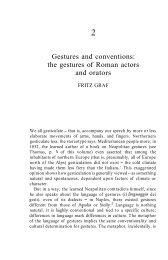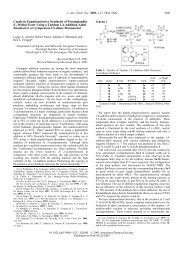Synthesis and application in asymmetric C–C bond formation of ...
Synthesis and application in asymmetric C–C bond formation of ...
Synthesis and application in asymmetric C–C bond formation of ...
You also want an ePaper? Increase the reach of your titles
YUMPU automatically turns print PDFs into web optimized ePapers that Google loves.
DOI: 10.1039/ b404996a<br />
<strong>Synthesis</strong> <strong>and</strong> <strong>application</strong> <strong>in</strong> <strong>asymmetric</strong> <strong>C–C</strong> <strong>bond</strong> <strong>formation</strong> <strong>of</strong><br />
solution phase lig<strong>and</strong> libraries <strong>of</strong> monodentate phosphoramidites†<br />
Ate Duursma, a Laurent Lefort, b Jeroen A. F. Boogers, b André H. M. de Vries, b<br />
Johannes G. de Vries,* a,b Adriaan J. M<strong>in</strong>naard* a <strong>and</strong> Ben L. Fer<strong>in</strong>ga* a<br />
a Department <strong>of</strong> Organic <strong>and</strong> Molecular Inorganic Chemistry, Strat<strong>in</strong>gh Institute,<br />
University <strong>of</strong> Gron<strong>in</strong>gen, Nijenborgh 4, 9747 AG Gron<strong>in</strong>gen, The Netherl<strong>and</strong>s.<br />
E-mail: b.l.fer<strong>in</strong>ga@chem.rug.nl; Fax: (31) 50-3634296; Tel: (31) 50-3634278<br />
b DSM Pharma Chemicals-Advanced <strong>Synthesis</strong>, Catalysis <strong>and</strong> Development, P.O. Box 18,<br />
6160 MD Geleen, The Netherl<strong>and</strong>s<br />
Received 2nd April 2004, Accepted 12th May 2004<br />
First published as an Advance Article on the web 25th May 2004<br />
A library <strong>of</strong> 96 unique monodentate phosphoramidite<br />
lig<strong>and</strong>s has been synthesized <strong>in</strong> solution <strong>and</strong> used <strong>in</strong> the<br />
<strong>asymmetric</strong> conjugate addition <strong>of</strong> potassium v<strong>in</strong>yltrifluoroborate<br />
to enones result<strong>in</strong>g <strong>in</strong> up to 88% ee.<br />
Comb<strong>in</strong><strong>in</strong>g enantioselective homogeneous catalysis <strong>and</strong><br />
comb<strong>in</strong>atorial chemistry <strong>in</strong> an efficient way is a highly desirable<br />
goal s<strong>in</strong>ce it leads to the rapid discovery <strong>of</strong> new catalysts<br />
for important <strong>asymmetric</strong> trans<strong>formation</strong>s. 1 However, comb<strong>in</strong>atorial<br />
approaches are <strong>of</strong>ten based on mixtures <strong>of</strong> compounds, 2<br />
whereas <strong>asymmetric</strong> catalysis requires the ability to <strong>in</strong>dividually<br />
detect the activity <strong>and</strong> selectivity <strong>of</strong> each catalyst <strong>in</strong> a library.<br />
Parallel reactions (one catalyst per vial), 3 followed by highthroughput<br />
screen<strong>in</strong>g, 4 has emerged as the method <strong>of</strong> choice<br />
comb<strong>in</strong><strong>in</strong>g these two fields. Impressive results have been<br />
obta<strong>in</strong>ed us<strong>in</strong>g solid-phase bound lig<strong>and</strong> libraries. 5 However,<br />
the translation <strong>of</strong> solution phase chemistry to the solid-phase<br />
<strong>and</strong> vice versa can be quite problematic, as illustrated by recent<br />
examples employ<strong>in</strong>g solid-phase bound phosphoramidite lig<strong>and</strong>s.<br />
6 We focused on an automated solution phase parallel<br />
synthesis <strong>of</strong> phosphoramidite libraries, s<strong>in</strong>ce it allowed the<br />
preparation <strong>of</strong> libraries (up to 96 members) <strong>in</strong> sufficient<br />
quantities us<strong>in</strong>g exist<strong>in</strong>g methodology. Phosphoramidites can<br />
be easily obta<strong>in</strong>ed by the reaction <strong>of</strong> a phosphorochloridite<br />
with a primary or secondary am<strong>in</strong>e <strong>in</strong> the presence <strong>of</strong> triethylam<strong>in</strong>e<br />
as a base. The modular structure makes them highly<br />
suitable for synthesis <strong>in</strong> a comb<strong>in</strong>atorial way (Scheme 1). 7<br />
Scheme 1 Phosphoramidite lig<strong>and</strong> synthesis.<br />
The automation <strong>of</strong> the synthesis is achieved by us<strong>in</strong>g all<br />
reagents as stock solutions, which are transferred by a liquid<br />
h<strong>and</strong>l<strong>in</strong>g robot placed <strong>in</strong> a glove box. 8 The chromatography<br />
normally performed at the end <strong>of</strong> the phosphoramidite synthesis,<br />
is replaced by a simple filtration, not only because it<br />
allows for a much more simple automated procedure, but also<br />
because phosphoramidites based on primary <strong>and</strong>/or aromatic<br />
am<strong>in</strong>es tend to decompose dur<strong>in</strong>g chromatography. For the<br />
parallel synthesis <strong>of</strong> the 96 lig<strong>and</strong> library accord<strong>in</strong>g to Fig. 1,<br />
toluene stock solutions <strong>of</strong> the three BINOL-based phosphorochloridites<br />
(Scheme 2) were added to a 96-well oleophobic<br />
filterplate <strong>in</strong> three areas <strong>of</strong> 32 wells respectively (Fig. 1).<br />
The addition <strong>of</strong> a stoichiometric amount <strong>of</strong> triethylam<strong>in</strong>e to<br />
each <strong>of</strong> the 96 wells was followed by the addition <strong>of</strong> a stoichiometric<br />
amount <strong>of</strong> 32 different am<strong>in</strong>es (Table 1) to each area<br />
† Electronic supplementary <strong>in</strong><strong>formation</strong> (ESI) available: experimental<br />
details. See http://www.rsc.org/suppdata/ob/b4/b404996a<br />
Fig. 1 Library synthesis.<br />
Scheme 2 Phosphorochloridites used.<br />
conta<strong>in</strong><strong>in</strong>g phosphorochloridites A–C, giv<strong>in</strong>g 96 different crude<br />
phosphoramidites based on three diols <strong>and</strong> 32 am<strong>in</strong>es.<br />
After two hours <strong>of</strong> agitation at room temperature on an<br />
orbital shaker, the precipitated triethylam<strong>in</strong>e hydrochloric acid<br />
salts were removed via parallel filtration. By plac<strong>in</strong>g the oleophobic<br />
filterplate on top <strong>of</strong> a 96-well microplate <strong>and</strong> apply<strong>in</strong>g<br />
vacuum, a library <strong>of</strong> 96 clear stock solutions <strong>of</strong> phosphoramidites<br />
<strong>in</strong> toluene was obta<strong>in</strong>ed. 31 P-NMR demonstrated<br />
that the lig<strong>and</strong>s were formed with >90% purity. The lig<strong>and</strong><br />
library was subsequently screened <strong>in</strong> the <strong>asymmetric</strong> conjugate<br />
addition <strong>of</strong> potassium v<strong>in</strong>yltrifluoroborate (2) to cyclohexenone<br />
(1) (Scheme 3). 9 The <strong>in</strong>troduction <strong>of</strong> a v<strong>in</strong>yl-group<br />
<strong>in</strong> an enantioselective fashion us<strong>in</strong>g a monodentate phosphoramidite<br />
lig<strong>and</strong> is highly desirable s<strong>in</strong>ce versatile synthons<br />
are produced, which up to now have only been obta<strong>in</strong>ed us<strong>in</strong>g<br />
Rh-BINAP catalysts. 10<br />
Scheme 3 Asymmetric conjugate addition <strong>of</strong> v<strong>in</strong>yltrifluoroborate.<br />
1682 Org. Biomol. Chem., 2004, 2, 1682–1684 This journal is © The Royal Society <strong>of</strong> Chemistry 2004
Table 1 Am<strong>in</strong>es used 50% ee). 12 The BINOL (A) based phosphoramidites perform<br />
much better, <strong>and</strong> the 8H-BINOL 13 (B) based lig<strong>and</strong>s even<br />
improve these results. Lig<strong>and</strong>s based on primary aromatic<br />
am<strong>in</strong>es lead to low conversions (5–39%) <strong>and</strong> ee values<br />
(11–37%). The most successful lig<strong>and</strong>s are based on 8H-<br />
BINOL <strong>and</strong> secondary aliphatic am<strong>in</strong>es like ethylmethylam<strong>in</strong>e<br />
(Fig. 2, 8e, 80% conv., 82% ee) <strong>and</strong> diethylam<strong>in</strong>e (Fig. 2, 1f, 81%<br />
conv., 87% ee). To validate the results these two lig<strong>and</strong>s were<br />
synthesized <strong>in</strong>dividually on a larger scale, <strong>in</strong>clud<strong>in</strong>g purification<br />
by column chromatograghy. The results correspond neatly with<br />
the ones from the solution phase library (96% conv., 86% ee for<br />
8e <strong>and</strong> 99% conv., 88% ee for 1f ) demonstrat<strong>in</strong>g the potential<br />
<strong>of</strong> this concept. Next to a cyclic enone, the acyclic enone benzylidene<br />
acetone (4) was also used a substrate <strong>in</strong> the screen<strong>in</strong>g <strong>of</strong><br />
the library (Scheme 4).<br />
Us<strong>in</strong>g the liquid h<strong>and</strong>l<strong>in</strong>g robot, a part <strong>of</strong> the entire solution<br />
phase library was transferred to 96 correspond<strong>in</strong>g reaction<br />
vials, followed by a stock solution <strong>of</strong> the rhodium source <strong>and</strong><br />
substrate 1 <strong>in</strong> ethanol. After the addition <strong>of</strong> trifluoroborate 2<br />
the vials were sealed, placed <strong>in</strong> a Premex 96-Multi Reactor, 11<br />
<strong>and</strong> heated at reflux for two hours. In order to allow a structure–activity<br />
<strong>and</strong> structure–selectivity analysis a short reaction<br />
time (2 h) was used whereby the reactions did not run to completion<br />
<strong>and</strong> a broad range <strong>of</strong> conversions <strong>and</strong> ee values is<br />
obta<strong>in</strong>ed. Analysis by chiral GC gave the results shown <strong>in</strong> Fig. 2.<br />
All the lig<strong>and</strong>s based on the 3,3-dimethyl-BINOL backbone<br />
(C) give low conversions <strong>and</strong> ee values, with the phosphoramidite<br />
based on anil<strong>in</strong>e as the best lig<strong>and</strong> (21% conv.,<br />
Fig. 2 Results <strong>of</strong> the library screen<strong>in</strong>g for the 1,4-addition <strong>of</strong> 2 to 1<br />
(ee upper row, conversion lower row).<br />
Scheme 4 Conjugate addition to benzylidene acetone.<br />
The reaction was run overnight <strong>and</strong> conversion <strong>and</strong> ee<br />
determ<strong>in</strong>ed by chiral GC. The results are shown <strong>in</strong> Fig. 3.<br />
As <strong>in</strong> the case <strong>of</strong> cyclohexenone, the BINOL (A) <strong>and</strong> 8H-<br />
BINOL (B) based phosphoramidites perform much better than<br />
the 3,3-dimethyl-BINOL (C) based lig<strong>and</strong>s; the latter giv<strong>in</strong>g<br />
conversions up to only 22% <strong>and</strong> ee values up to 29% (Fig. 3, 4l).<br />
The most effective lig<strong>and</strong>s, show<strong>in</strong>g high conversion although<br />
moderate ee so far, are based on cyclic am<strong>in</strong>es conta<strong>in</strong><strong>in</strong>g ester<br />
substituents (3d, 3h, <strong>and</strong> 4b with ee values <strong>of</strong> 42%, 40%, <strong>and</strong><br />
41%, respectively).<br />
Fig. 3 Results <strong>of</strong> the library screen<strong>in</strong>g for the 1,4-addition <strong>of</strong> 2 to 4.<br />
In summary we have shown that solution phase libraries <strong>of</strong><br />
chiral monodentate phosphoramidite are rapidly synthesized<br />
<strong>and</strong> screened <strong>in</strong> <strong>asymmetric</strong> <strong>C–C</strong> <strong>bond</strong> form<strong>in</strong>g reactions us<strong>in</strong>g<br />
an automated parallel protocol. This method leads to the quick<br />
discovery <strong>of</strong> (leads for) effective enantioselective catalysts for<br />
various trans<strong>formation</strong>s <strong>and</strong>, <strong>in</strong> association with the monodentate<br />
lig<strong>and</strong> comb<strong>in</strong>ation approach recently <strong>in</strong>troduced, 14<br />
provides a powerful tool for comb<strong>in</strong>atorial <strong>asymmetric</strong><br />
catalysis.<br />
Org. Biomol. Chem., 2004, 2, 1682– 1684<br />
1683
Acknowledgements<br />
We thank the European Commission (IHP Network grant<br />
“CombiCat” HPRN-CT-2000-00014) for f<strong>in</strong>ancial support.<br />
Notes <strong>and</strong> references<br />
1(a) J. G. de Vries <strong>and</strong> A. H. M. de Vries, Eur. J. Org. Chem.,<br />
2003, 799; (b) C. Gennari <strong>and</strong> U. Piarulli, Chem. Rev., 2003, 103,<br />
3071.<br />
2 D. L. C<strong>of</strong>fen <strong>and</strong> J. E. A. Luithle, <strong>in</strong> H<strong>and</strong>book <strong>of</strong> Comb<strong>in</strong>atorial<br />
Chemistry, eds. K. C. Nicolaou, R. Hanko <strong>and</strong> W. Hartwig,<br />
Wiley-VCH, We<strong>in</strong>heim, 2002, vol. 1, p. 10.<br />
3(a) B. J<strong>and</strong>eleit, D. Schaefer, T. S. Powers, H. W. Turner <strong>and</strong><br />
W. H. We<strong>in</strong>berg, Angew. Chem., Int. Ed., 1999, 38, 2494;<br />
(b) M. T. Reetz, Angew. Chem., Int. Ed., 2001, 40, 284.<br />
4(a) M. T. Reetz, Angew. Chem., Int. Ed., 2002, 41, 1335;<br />
(b) A. Duursma, A. J. M<strong>in</strong>naard <strong>and</strong> B. L. Fer<strong>in</strong>ga, Tetrahedron,<br />
2002, 58, 5773.<br />
5 N. E. Leadbeater <strong>and</strong> M. Marco, Chem. Rev., 2002, 102, 3217.<br />
6(a) O. Huttenloch, E. Laxman <strong>and</strong> H. Waldmann, Chem.<br />
Commun., 2002, 673; (b) S. Doherty, E. G. Rob<strong>in</strong>s, I. Pál,<br />
C. R. Newman, C. Hardacre, D. Rooney <strong>and</strong> D. A. Mooney, Tetrahedron:<br />
Asymmetry, 2003, 14, 1517; (c) A. M<strong>and</strong>oli, M. Calamante,<br />
B. L. Fer<strong>in</strong>ga <strong>and</strong> P. Salvadori, Tetrahedron: Asymmetry, 2003, 14,<br />
3647.<br />
7 J. G. Boiteau, A. J. M<strong>in</strong>naard <strong>and</strong> B. L. Fer<strong>in</strong>ga, J. Org. Chem., 2003,<br />
68, 9481.<br />
1684 Org. Biomol. Chem., 2004, 2, 1682– 1684<br />
8 L. Lefort, J. A. F. Boogers, A. H. M. de Vries <strong>and</strong> J. G. de Vries,<br />
Org. Lett., 2004, 6, 1733.<br />
9 For the 1,4-addition <strong>of</strong> arylboronic acids us<strong>in</strong>g phosphoramidite<br />
based catalysts see: (a) J. G. Boiteau, R. Imbos, A. J. M<strong>in</strong>naard <strong>and</strong><br />
B. L. Fer<strong>in</strong>ga, Org. Lett., 2003, 5, 681; (b) J. G. Boiteau, R. Imbos,<br />
A. J. M<strong>in</strong>naard <strong>and</strong> B. L. Fer<strong>in</strong>ga, Org. Lett., 2003, 5, 1385;<br />
(c) A. Duursma, R. Hoen, J. Schuppan, R. Hulst, A. J. M<strong>in</strong>naard<br />
<strong>and</strong> B. L. Fer<strong>in</strong>ga, Org. Lett., 2003, 5, 3111; (d ) J. G. Boiteau, A. J.<br />
M<strong>in</strong>naard <strong>and</strong> B. L. Fer<strong>in</strong>ga, J. Org. Chem., 2003, 68, 9481;<br />
(e) Y. Iguchi, R. Itooka <strong>and</strong> N. Miyaura, Synlett, 2003, 7, 1040.<br />
Further details <strong>of</strong> the 1,4-addition <strong>of</strong> v<strong>in</strong>yltrifluoroborate will be<br />
published <strong>in</strong> due course.<br />
10 (a) M. Pucheault, S. Darses <strong>and</strong> J. P. Genet, Eur. J. Org. Chem., 2002,<br />
3552; (b) S. Oi, A. Taira, Y. Honma <strong>and</strong> Y. Inoue, Org. Lett., 2003, 5,<br />
97.<br />
11 This reactor was developed by Premex <strong>in</strong> cooperation with DSM,<br />
see:<br />
www.premex-reactorag.ch/e/specialloesungen/produkteneuheiten.<br />
12 The poorer results with sterically h<strong>in</strong>dered phosphorochloridite C<br />
are not the result <strong>of</strong> <strong>in</strong>complete lig<strong>and</strong> <strong>formation</strong> as was evident<br />
from NMR analysis.<br />
13 T. T.-L. Au-Yeung, S.-S. Chan <strong>and</strong> A. S. C. Chan, Adv. Synth. Catal.,<br />
2003, 345, 537.<br />
14 (a) M. T. Reetz, T. Sell, A. Meisw<strong>in</strong>kel <strong>and</strong> G. Mehler, Angew.<br />
Chem., Int. Ed., 2003, 42, 790; (b) D. Peña, A. J. M<strong>in</strong>naard, J. A. F.<br />
Boogers, A. H. M. de Vries, J. G. de Vries <strong>and</strong> B. L. Fer<strong>in</strong>ga,<br />
Org. Biomol. Chem., 2003, 1, 1087; (c) A. Duursma, R. Hoen,<br />
J. Schuppan, R. Hulst, A. J. M<strong>in</strong>naard <strong>and</strong> B. L. Fer<strong>in</strong>ga, Org. Lett.,<br />
2003, 5, 3111.
















